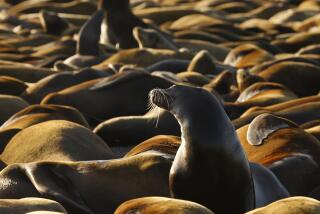Orky, Oldest Killer Whale in Captivity, Dies
Three days after delighted spectators watched the birth of the calf he sired, Orky the killer whale died at Sea World.
The death Monday leaves the amusement park chain with only one proven breeding male among its 12 surviving whales, dealing a blow to the breeding program it hopes will supply killer whales for shows at the park.
Seven-ton Orky, at 30 or so the oldest killer whale in captivity, was so important to that breeding program that Sea World paid $23.4 million for Orky’s home, Marineland of the Pacific, in 1987. Some observers saw the move as a bid mainly to acquire Orky and his mate, and Harcourt Brace Jovanovich, owner of Sea World, closed Marineland shortly after the acquisition.
Orky died early Monday morning after refusing the regular feeding offered to him and the three adult females at the park, said Jim Antrim, general curator. He died about two hours later, before the park had been opened, Antrim said.
“It’s customary to give them a first feeding bright and early in the morning,” Antrim said. “He always was very predictable in his coming over and enthusiasm for eating. He wasn’t interested in eating. He was swimming in tight circles in the center of the pool and appeared to be having some balance and respiratory problems, and then he very quickly sank to the bottom and died.”
An autopsy will be performed by Sea World and the results reported to the National Marine Fisheries Service, which issues permits for holding killer whales in captivity, Antrim said.
Orky was captured off the British Columbia coast in 1968. In his 20 years in captivity, the 24-foot whale exhibited a more aggressive personality than his smaller female companions. He was also the whale that landed on top of a trainer in November, seriously injuring him and temporarily halting performances by trainers in the water.
Shortly after arriving at the park in January, 1987, from Marineland, Orky bred with Kandu, mother of the new baby, and with a whale that is now pregnant and at Sea World’s San Diego park, Antrim said.
But caretakers at the park had noticed a general slowdown in Orky within a few months of his arrival, Antrim said. The symptoms resembled those one might see in an aging human, he said.
Orky’s death leaves Sea World with only two males, one about 20 to 25 years old in Orlando, Fla., and a second about to reach sexual maturity in San Antonio, Antrim said. The new baby in San Diego is thought to be female.
Sea World officials say they still have enough males to operate a viable breeding program, however.
They also said they are heartened that Orky fathered two calves with new mates before dying--something that wouldn’t have happened if he had stayed at Marineland, said Brad Andrews, vice president for marine mammals at Sea World.
Orky and mate Corky had produced six offspring at Marineland’s smaller facilities, but two were stillborn and the four others died after birth. This apparently was at least partly because Corky, isolated from other females, didn’t know how to treat a calf.
“I think it’s very important that this didn’t happen at the facilities at Marineland,” said Andrews, who was at Marineland until it was closed. “That was my worst fear, to have he and Corky producing offspring that weren’t living. It was very important for the animals to be moved to a larger facility in 1987 so he could be exposed to other animals.”
Orky’s calf, as well as the two expected within the next month or two in Florida and Texas, have much better chances for survival in the new, larger facilities with multiple females where the whales are kept now, Antrim and whale biologists said. However, environmentalists can be expected to continue to oppose Sea World’s efforts to keep killer whales in captivity.
High Death Rate
Studies show that, if there are 20 whales in captivity, at least one of them will die every year, said Douglas DeMaster, a marine mammal biologist for the Fisheries Service in San Diego. In the early years of concerted capture programs, in the late 1960s and early 1970s, the survival rate was much poorer.
“We’re obviously deeply saddened that Orky has passed away,” said Alan Reichman, ocean ecology coordinator for Greenpeace in Seattle. “It’s not surprising to us, though, given the abysmal record for orcas that are held in captivity. Actually, Orky’s life span was longer than that of most other captive orcas, but this death as well as the premature deaths of other orcas illustrates that orcas simply aren’t amenable to living in swimming pools.”
Greenpeace opposes all efforts to capture killer whales or keep them captive, he said. It filed the lawsuit that in 1985 prevented Sea World from capturing 100 killer whales off Alaska and effectively squelched any plans for capture.
Orky was “by far the oldest animal in captivity,” said Deborah Duffield, an Oregon biology professor who has studied the captive population in the United States and Canada.
With Orky’s death and the recent birth, there are 22 killer whales in captivity in the two nations, she said. There have only been 10 births to the animals captured since the 1960s, and, of those there are only two survivors, a 3-year-old calf at Sea World in Florida and the new calf in San Diego.
Contested Issue
Two more calves are on the way in Texas and Florida, and another birth is expected in Canada, Duffield said.
Longevity is a hotly contested issue among the whale research community, with environmentalists contending that whales live much longer in the wild than in captivity.
Males are thought to live at least 30 years, and some estimates are as high as 50 years. Females are thought to live slightly longer. But one study in Canada recently concluded that females can live as long as 80 years in the wild.
Still, at an estimated 27 to 32 years, Orky was very long-lived for a captive whale, biologists said.
Studies by Canadian researchers and others have shown that killer whale groups, called pods, are a matriarchal society, made up of a dominant female and her children, grandchildren and perhaps great-grandchildren. Males appear to both stay within the family group and, on occasion, to become lone wanderers that approach groups of females only to breed.
This female-centered social organization was thought to be what was missing, for instance, when Corky--without any other females around--proved to be an inadequate mother to her four live offspring at Marineland, Duffield noted.
That problem has been addressed at Sea World by keeping groups of females who, as occurs in elephant societies, serve as “aunties” to help the new mother.
For now, the calf born Friday at Sea World is being kept in the large performing pool with its mother, Antrim said, and all killer whale performances have been canceled. The first month of life is the most critical for the calf.
Modified performances could begin within a week, he said, adding that the Florida calf was participating in shows with its mother within two months of birth.
More to Read
Sign up for Essential California
The most important California stories and recommendations in your inbox every morning.
You may occasionally receive promotional content from the Los Angeles Times.










